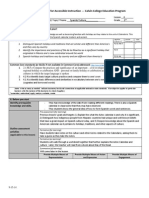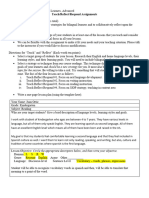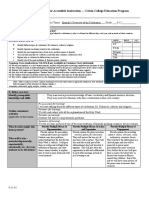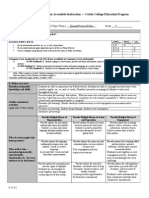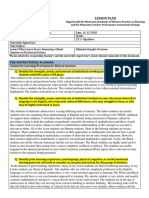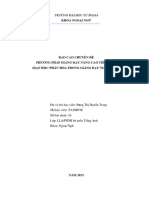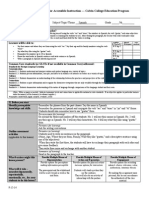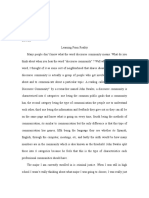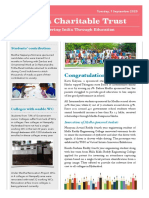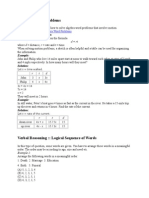Done - Lesson 5
Done - Lesson 5
Uploaded by
api-300733155Copyright:
Available Formats
Done - Lesson 5
Done - Lesson 5
Uploaded by
api-300733155Original Title
Copyright
Available Formats
Share this document
Did you find this document useful?
Is this content inappropriate?
Copyright:
Available Formats
Done - Lesson 5
Done - Lesson 5
Uploaded by
api-300733155Copyright:
Available Formats
Lesson Planning Form for Accessible Instruction Calvin College Education Program
Teacher
Melissa Rivera
Date
11/6/15
Subject/ Topic/ Theme _Spanish/Expresando el Calendario___
Lesson __5_______
Grade ___9th______
I. Objectives
How does this lesson connect to the unit plan?
Students apply all of their learned knowledge (vocab, grammar, and culture) related to the unit el Calendario in this lesson as they review and then
complete a quiz. This incorporates the organization/framework of the Spanish calendar, pronunciation, and Spanish holidays.
Learners will be able to:
1. Express answers to various familiar questions regarding birthday, date, and culture.
2.
3.
4.
Compare holidays and traditions between America and Spanish-speaking countries,
explaining that Da de los Muertos is a significant holiday that originated in Mexico and is
now celebrated around the world. Indigenous people from Hispanic countries had unique
and well-known beliefs that have a great impact on Spanish culture today
Apply the difference between the Spanish and American grammatical structures
Describe that the Spanish calendar is very similar to our own, but it holds that Monday is
the first day of the week in its layout
cognitiveR U Ap An E C*
R, U, Ap,
C, E
R, U, Ap,
An, E
physical
development
socioemotional
*
*
R, U, Ap
R, U, Ap
Common Core standards (or GLCEs if not available in Common Core) addressed: https://www.michigan.gov/documents/mde/WLSB_206824_7.pdf
1. 1.1.N.SL.h Exchange information in the target language on familiar topics such as personal interests, memorable
experiences, school activities, and family life
2. 2.1.M.F.e Compare the practices and significance of an important: - civil or religious holiday or celebration AND regional holiday or celebration AND - personal or family holiday or celebration across multiple communities or
cultures in which the target language is spoken
3. 4.1.M.b Select grammatical structures recognizing that meaning is not always conveyed through direct word-for-word
translation from ones own language to the target language
4. 4.2.N.a Identify basic target culture practices and compare them to ones own
(Note: Write as many as needed. Indicate taxonomy levels and connections to applicable national or state standards. If an objective applies to particular learners
write the name(s) of the learner(s) to whom it applies.)
*remember, understand, apply, analyze, evaluate, create
II. Before you start
Identify prerequisite
knowledge and skills.
They have knowledge of the date from reading different readings. There is also a Spanish
calendar in classrooms that they may have observed.
They students know the general idea of how to form Spanish words and sentences.
Pre-assessment (for learning):
Outline assessment
activities
(applicable to this lesson)
1) Distinguish Spanish holidays and traditions that are similar and different than Americas and they
vary by country. 2) Identify the importance and practices of Da de los Muertos as a significant
holiday that originated in Mexico and is now celebrated around the world
3) Spanish holidays and traditions vary by country and are different than Americas
Formative (for learning):
Have students complete a practice quiz and review in a large-group discussion.
Formative (as learning):
Summative (of learning):
Final unit quiz that measures most objectives to meet the goals pre-determined for this unit.
Provide Multiple Means of
Representation
9-15-14
Provide Multiple Means of
Action and Expression
Provide Multiple Means of
Engagement
What barriers might this
lesson present?
What will it take
neurodevelopmentally,
experientially,
emotionally, etc., for your
students to do this lesson?
Provide options for perceptionmaking information perceptible
Provide options for physical actionincrease options for interaction
Provide options for recruiting
interest- choice, relevance, value,
authenticity, minimize threats
The students might experience
difficulty remembering the vocab
because learners often struggle to
memorize in a foreign language.
Thus, I will write and say the vocab
then have students repeat.
Have students sing songs and
dance for memorization and action.
Then, they will create flash cards to
play bingo with after they take note
of vocab terms. They will need to
repeat words.
Provide options for language,
mathematical expressions, and
symbols- clarify & connect
language
Provide options for expression and
communication- increase medium
of expression
If the students have time to practice
the vocab in a large group game, I
will allow students to choose to
play memoria or cucharas to
continue practicing. This will
provide an option and engagement
initiated by the students.
Provide options for sustaining
effort and persistence- optimize
challenge, collaboration, masteryoriented feedback
Give students the vocab
verbally and orthographically
in context of our lesson so that
they can make connections.
Provide options for comprehensionactivate, apply & highlight
Ask students where they might
have heard or will use the
language at hand.
Materials-what materials
(books, handouts, etc) do
you need for this lesson
and are they ready to
use?
How will your classroom
be set up for this lesson?
Students will go through a
birthday worksheet activity
between partners to practice
speech and grammar in
different way.
The students will practice
speaking in Spanish, providing
a challenge and collaboration
between peers with feedback.
Provide options for executive
functions- coordinate short & long
term goals, monitor progress, and
modify strategies
Provide options for self-regulationexpectations, personal skills and
strategies, self-assessment &
reflection
Give the students a worksheet
on goals for the unit.
Students will have given
worksheets and flash cards they
made so that they can go
through them and self-assess.
dry erase markers, paper, markers/pens, overhead projection/document camera, Unit quiz
The classroom is set up in individual desks so that students wont be tempted to cheat or distracted by
their partner.
III. The Plan
Time
Describe teacher activities
AND
student activities
for each component of the lesson. Include important higher order thinking questions and/or
prompts.
Components
80 min
4
1
Motivation
(opening/
introduction/
engagement)
1.
2.
9-15-14
Welcome the class in Spanish. Begin by
saying the date, praying, and asking basic
questions for the unit to get a feel for their
understanding of Spanish, then explain that
sentence based on their responses.
- Qu da es hoy?
- Qu es la fecha hoy?
- Cuntos aos tienes?
- Cundo es tu cumpleaos?
Tell students we will have a short time of
review before the quiz. Are there any
questions over the practice quiz?
1.
Pay attention and respond to questions.
2.
Listen (make connections).
- Look over goals and begin to make
connections between prior and future
knowledge.
- What do I know? What do I not know and
need to ask about?
20
3.
4.
Answer any questions. Asked by students.
Play a quick review game: vocab races
5.
Hand out quiz over the unit.
3.
4.
Ask questions
Participate in game by answering
questions and asking when confused.
30
Development
(the largest
component or
main body of
the lesson)
5.
Use materials to make flashcards (building
knowledge of the vocab as they work).
- go over instructions with students to
avoid any confusion
10
10
As the class comes to an, students who 6. Quietly color while everyone finishes.
have finished the quiz can color day of
the Dead pages.
3
7. The teacher may point to the calendar 7. Students listen and tidy their workspace.
to point out any Hispanic holidays
such as Navidad and Ao Nuevo that
2
are approaching quickly.
8. Engage, listen, and contemplate the different
8. This will give the students a preview
holidays around the world, specifically in
of the cultural lessons to come.
Spanish-speaking countries.
Preview the next unit.
Your reflection about the lesson, including evidence(s) of student learning and engagement, as well as ideas for improvement
for next time. (Write this after teaching the lesson, if you had a chance to teach it. If you did not teach this lesson, focus on the
process of preparing the lesson.)
Closure
(conclusion,
culmination,
wrap-up)
6.
The students have the ultimate task of bringing all they have learned and displaying it on the quiz in this lesson. This makes
me nervous because I will have the task of providing and guiding them through all of the unit content. It is particularly
interesting because, again, I am in a room that is for students with learning disabilities, and I am wondering if the review
game and practice quiz would be too much review for the students or the perfect amount. In any classroom, I believe it would
be a beneficial amount of review and preparation for a quiz. As I prepare for this lesson, I wonder how my role in each lesson
can be best implemented. I know that my enthusiasm in each game and activity will have an effect on my learners. Thus, I
want to focus on creating a healthy classroom environment to eliminate as many barriers as possible. In this way and others,
I know I have seen growth in myself merely planning each unit here, so I hope to see similar results in the students I teach.
9-15-14
You might also like
- Assure Model Lesson PlanDocument2 pagesAssure Model Lesson PlanHasifuddinMdNoor92% (25)
- Csulb World Languages Lesson Plan TemplateDocument4 pagesCsulb World Languages Lesson Plan Templateapi-529012212No ratings yet
- Done - Lesson 1Document4 pagesDone - Lesson 1api-300733155No ratings yet
- Done - Lesson 4Document4 pagesDone - Lesson 4api-300733155No ratings yet
- Done - Lesson 2Document4 pagesDone - Lesson 2api-300733155No ratings yet
- Done - Lesson 3Document4 pagesDone - Lesson 3api-300733155No ratings yet
- TeachReflectRespond 4Document3 pagesTeachReflectRespond 4miloortizbernalNo ratings yet
- TeachReflectRespond 3Document5 pagesTeachReflectRespond 3miloortizbernalNo ratings yet
- Lesson Planning Form For Accessible Instruction - Calvin College Education ProgramDocument4 pagesLesson Planning Form For Accessible Instruction - Calvin College Education Programapi-318497844No ratings yet
- Lesson Plan 3Document3 pagesLesson Plan 3api-318497844No ratings yet
- Amy 1st Hs Observation Lesson Plan 1Document7 pagesAmy 1st Hs Observation Lesson Plan 1api-308661992No ratings yet
- Fallas Lesson 1 FinalDocument3 pagesFallas Lesson 1 Finalapi-284251745No ratings yet
- Complete Unit PlanDocument18 pagesComplete Unit Planapi-268989441No ratings yet
- Fallas Lesson 5 FinalDocument3 pagesFallas Lesson 5 Finalapi-284251745No ratings yet
- Instructional Plan Edi 432Document9 pagesInstructional Plan Edi 432api-456862819No ratings yet
- KGUtierrez Lessons May 15Document10 pagesKGUtierrez Lessons May 15Kimberly GutierrezNo ratings yet
- Sdaie Multicultural Lesson J MunguiaDocument16 pagesSdaie Multicultural Lesson J Munguiaapi-235555632No ratings yet
- Common Core Lesson Planner: Grade Level: High School 9-12 Subject: Spanish Non-Natives Teacher: Cecilia SerratoDocument4 pagesCommon Core Lesson Planner: Grade Level: High School 9-12 Subject: Spanish Non-Natives Teacher: Cecilia Serratoapi-428835566No ratings yet
- Imperfectlessonplan 5Document3 pagesImperfectlessonplan 5api-284249375No ratings yet
- Grace Kim Lesson Plan 2 UpdatedDocument4 pagesGrace Kim Lesson Plan 2 Updatedapi-301154896No ratings yet
- ThanksgivingDocument3 pagesThanksgivingapi-302452610No ratings yet
- Guia 19 CMI Presentacion - ModeloDocument38 pagesGuia 19 CMI Presentacion - ModeloWilberNo ratings yet
- Lesson Plan 2Document3 pagesLesson Plan 2api-318497844No ratings yet
- Lesson Planning CertTESOLDocument8 pagesLesson Planning CertTESOLbishal_rai_2No ratings yet
- Completed Study of Student Achievement-CompressedDocument76 pagesCompleted Study of Student Achievement-Compressedapi-496402269No ratings yet
- Fallas Lesson 4 FinalDocument3 pagesFallas Lesson 4 Finalapi-284251745No ratings yet
- Lesson 1 Udl 1Document5 pagesLesson 1 Udl 1api-480773487No ratings yet
- Multicultural Lesson Plan EDSS 555Document7 pagesMulticultural Lesson Plan EDSS 555prestonrhillNo ratings yet
- SPHS 3 Lesson Plan 11-14Document5 pagesSPHS 3 Lesson Plan 11-14prestonrhillNo ratings yet
- Filled InproffeshcompDocument13 pagesFilled Inproffeshcompapi-312468002No ratings yet
- Lesson Planning - Short Review and SampleDocument5 pagesLesson Planning - Short Review and SampleYamith J. Fandiño100% (2)
- MDD 234 FinalDocument7 pagesMDD 234 Finalapi-237560763No ratings yet
- ExplicitlessonplanDocument11 pagesExplicitlessonplanapi-247251809No ratings yet
- Lesson Plan FamilyDocument8 pagesLesson Plan Family16139280100% (1)
- Lesson Plan Format For Teacher Education Candidates Ithaca College School of Humanities and SciencesDocument6 pagesLesson Plan Format For Teacher Education Candidates Ithaca College School of Humanities and Sciencesapi-285942234No ratings yet
- STEPP Lesson Plan Form: Content Standard(s) Addressed by This LessonDocument6 pagesSTEPP Lesson Plan Form: Content Standard(s) Addressed by This Lessonapi-264548225No ratings yet
- LESSON PLAN Finger FamilyDocument7 pagesLESSON PLAN Finger Family16139280No ratings yet
- Mait 404 Lesson 8Document5 pagesMait 404 Lesson 8api-300525347No ratings yet
- TPA Elementary Lesson Plan Template Teacher Candidate: Grade Level: Date: Subject: Instructional Plan Title: 1. Lesson Overview or Summary: in A FewDocument178 pagesTPA Elementary Lesson Plan Template Teacher Candidate: Grade Level: Date: Subject: Instructional Plan Title: 1. Lesson Overview or Summary: in A Fewapi-317477300No ratings yet
- Redo Pumpkins Day 2Document2 pagesRedo Pumpkins Day 2api-406714715No ratings yet
- ACLSPU031 - ScootleDocument14 pagesACLSPU031 - Scootleapi-524427620No ratings yet
- Lesson Plan: Pre-Instructional PlanningDocument10 pagesLesson Plan: Pre-Instructional PlanningBenturaNo ratings yet
- Spanish2 Term1 Hs Mrs Navarro Doc 1Document13 pagesSpanish2 Term1 Hs Mrs Navarro Doc 1api-264184239No ratings yet
- Lesson Plan 1Document4 pagesLesson Plan 1api-283392025No ratings yet
- Đặng Thị Huyền Trang - DH PHÂN HÓADocument15 pagesĐặng Thị Huyền Trang - DH PHÂN HÓAlinhnhoo1612No ratings yet
- Assignment Packet Hs Spanish 1 Term3 Mrs NavarroDocument7 pagesAssignment Packet Hs Spanish 1 Term3 Mrs Navarroapi-264184239100% (1)
- Lesson Plan Commentary Feb 5thDocument2 pagesLesson Plan Commentary Feb 5thapi-245889868No ratings yet
- Spanish Interpersonal Family Unit PlanDocument8 pagesSpanish Interpersonal Family Unit PlanTinaNo ratings yet
- Major Assignment #3 Lesson Plan GuidelinesDocument16 pagesMajor Assignment #3 Lesson Plan GuidelinesJessica PulidoNo ratings yet
- Lesson Plan 2Document3 pagesLesson Plan 2api-283392025No ratings yet
- EDU 6828 Unit Plan Spanish Greetings and GoodbyesDocument25 pagesEDU 6828 Unit Plan Spanish Greetings and GoodbyesHaderbachi AmineNo ratings yet
- Edu 305 Parts of Speech Lesson PlanDocument3 pagesEdu 305 Parts of Speech Lesson Planapi-342432899No ratings yet
- Lesson 5 FinalDocument4 pagesLesson 5 Finalapi-301154896No ratings yet
- Modelo CallaDocument8 pagesModelo Callapunition_d_anges100% (1)
- Lessons TwsDocument40 pagesLessons Twsapi-281027473No ratings yet
- Universal Design Learning Lesson PlanDocument20 pagesUniversal Design Learning Lesson Planapi-243411808No ratings yet
- Artifact #3: Unit Plan Project: Why Did You Include This Artifact?Document36 pagesArtifact #3: Unit Plan Project: Why Did You Include This Artifact?api-288966220No ratings yet
- Howdy! Starter Annual PlanningDocument32 pagesHowdy! Starter Annual PlanningGisela Sol100% (4)
- End-Term Assignment: Muneesa's Lesson PlanDocument6 pagesEnd-Term Assignment: Muneesa's Lesson PlanLubna ShamsuNo ratings yet
- Monthly Accomplishment Report PlainDocument1 pageMonthly Accomplishment Report PlainRaysiel Parcon MativoNo ratings yet
- Word Jumble RaceDocument8 pagesWord Jumble Raceعباس معنىNo ratings yet
- Hpe-Forward-Planning-Document FinishedDocument5 pagesHpe-Forward-Planning-Document Finishedapi-281693390No ratings yet
- Examination School/College Board/ University Year of PassingDocument2 pagesExamination School/College Board/ University Year of PassingrahulNo ratings yet
- B LOUVAIN01-Fact Sheet Final 2021-2022Document3 pagesB LOUVAIN01-Fact Sheet Final 2021-2022Joseph El KhouryNo ratings yet
- Lesson Plan tp3Document3 pagesLesson Plan tp3api-338155581No ratings yet
- Gallo - EleanoraT - CPA Week 2Document3 pagesGallo - EleanoraT - CPA Week 2Eleanora T. GalloNo ratings yet
- Revised SUPW Framework 2013Document15 pagesRevised SUPW Framework 2013nilaNo ratings yet
- SyllogismDocument18 pagesSyllogismKarthik Suvarna100% (1)
- Conflict in The Family Fall19Document7 pagesConflict in The Family Fall19vivek khetaniNo ratings yet
- PPG Module TSL3105 Topic 6 Planning Remedial & Enrichmt ActivitiesDocument7 pagesPPG Module TSL3105 Topic 6 Planning Remedial & Enrichmt ActivitiesMissBigHead100% (2)
- Even Geniuses Work Hard, Dweck 2010Document4 pagesEven Geniuses Work Hard, Dweck 2010Anonymous poXLzLfNo ratings yet
- Sabrina Zuniga Fbi Final For WeeblyDocument9 pagesSabrina Zuniga Fbi Final For Weeblyapi-294807514No ratings yet
- International Student Application Form:: Personal DetailsDocument4 pagesInternational Student Application Form:: Personal DetailsKaran KunduNo ratings yet
- Medha Charitable Trust: Congratulations ToppersDocument1 pageMedha Charitable Trust: Congratulations ToppersRamesh YadlaNo ratings yet
- The Impact of Effective Teaching Strategies On THDocument14 pagesThe Impact of Effective Teaching Strategies On THQuinonez Anna Marie50% (2)
- NUS NEC Papers Set 2 For 17 SeptDocument118 pagesNUS NEC Papers Set 2 For 17 SeptEdmund R SchNo ratings yet
- NUST Academic Schedule 2020-21 - Final On 6 Oct 2020Document7 pagesNUST Academic Schedule 2020-21 - Final On 6 Oct 2020Hamza LatifNo ratings yet
- Warm UpDocument8 pagesWarm UpmarioNo ratings yet
- Algebra Motion Problems Set 1Document7 pagesAlgebra Motion Problems Set 1Eric GonzaloNo ratings yet
- Short Stories UBD TemplateDocument4 pagesShort Stories UBD TemplateSam WillettNo ratings yet
- Research On Gender Differences Chapter 1 To 3Document10 pagesResearch On Gender Differences Chapter 1 To 3Kathy Tamtech0% (1)
- Tech Drawing Syllabus - TDDocument2 pagesTech Drawing Syllabus - TDapi-237516908No ratings yet
- Developmental Phases ofDocument5 pagesDevelopmental Phases ofPARTIVEN A/L MUNIANDY -No ratings yet
- Teaching Resume Jennifer de GuzmanDocument2 pagesTeaching Resume Jennifer de GuzmanJennifer DGNo ratings yet
- Science Lesson Summary and ReflectionDocument5 pagesScience Lesson Summary and Reflectionapi-282680348No ratings yet
- Statement of Marks PDFDocument2 pagesStatement of Marks PDFPavan ShekarNo ratings yet
- Applicationform Academic UitmDocument2 pagesApplicationform Academic UitmNuril Aslina Che HussinNo ratings yet
- AES Colloquium FINALDocument29 pagesAES Colloquium FINALMandig Montilde John RayNo ratings yet




